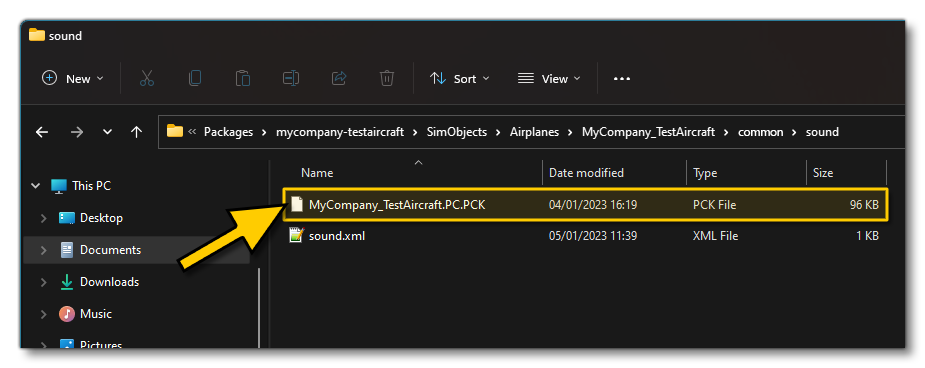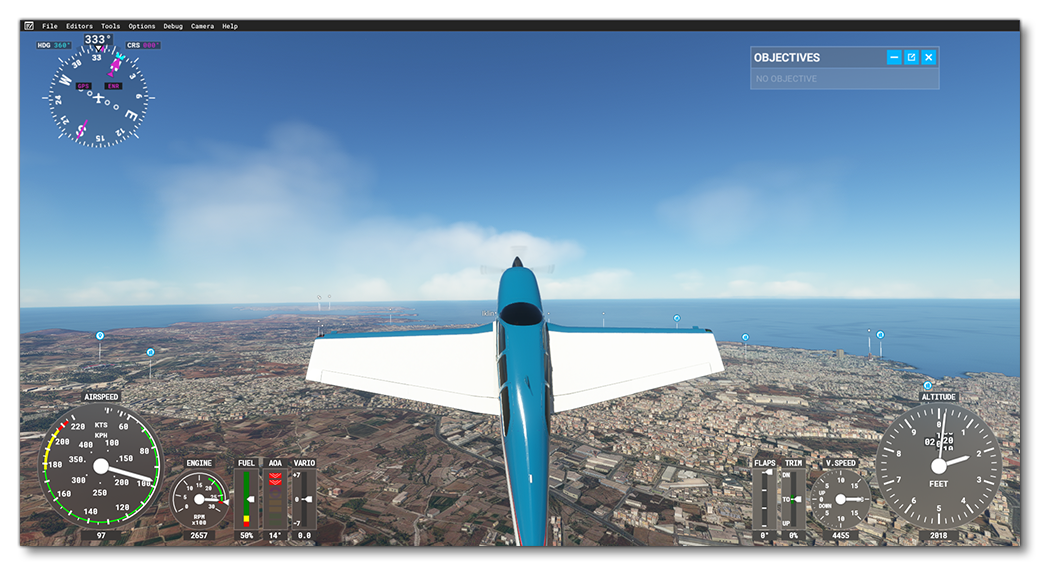CREATING THE SOUND.XML
In this section we'll look at creating the basic sound.xml file that will be used by aircraft to link the sounds available in the sound package (created using Wwise, as explained here: Setting Up Wwise). We'll be taking you through the steps required to create the file from scratch and have it link with a single sound to be played in the simulation. The process outlined will generally be the same for all of the simple sounds required by an aircraft, and this is designed to give you a starting point for adding further sounds afterwards. We also have a more complex tutorial that covers how to create the audio required for engine sound effects, which you can find here:
This page does not cover any specific details related to modular aircraft or SimObjects. The general setup for modular SimObjects still requires the information on this page, but there are some additional caveats that should be noted before continuing with that kind of SimObject, which are listed here:
Note that we won't be going into too much depth about any of the XML elements used in this tutorial, as those are all covered in full on the following page of the main documentation:
Finally, you can find a tutorial video related to the contents of the sound.xml file below:
Create The sound.xml File
The first thing you'll need to do is go to the aircraft project that you're working on and open the sound folder in the main project directory (or create this folder if it doesn't exist, although if you've followed the Setting Up Wwise tutorial then the folder should exist already with the audio package in it). The folder should be found here:
<ROOT>\[MyCompany_MyAircraft]\PackageSources\SimObjects\Airplanes\[MyCompany_MyAircraft]\common\sound
In this folder you then want to create a new XML file called sound.xml (right click, select New > Text Document, and save as sound.xml):

NOTE: For simplicity, everything is being saved in the common folder of the aircraft, however for more complex modular sim aircraft and objects you may wish to save multiple XML and PC.PCK files, for example, in seperate attachments. For more information please see the section on Sounds And Modular SimObjects.
Edit The sound.xml File
With the file created, you can now open it in your editor of choice and add in the following lines:
<?xml version="1.0" encoding="utf-8" ?>
<SoundInfo Version="0.1">
</SoundInfo>These lines are required for the sound.xml file to be functional, and will be required every time you need to create this file.
Once you have that base written, you can then add the <WwisePackages> container element, where you will specify your <MainPackage> (and - if needed - an <AdditionalPackage>):
<?xml version="1.0" encoding="utf-8" ?>
<SoundInfo Version="0.1">
<WwisePackages>
<MainPackage Name="MyCompany_MyAircraft">
</WwisePackages>
</SoundInfo>Note that the package name is given without the PC.PCK extension.
The final step in this procedure is to add in a <Sound> element that defines the sound you want to use, which in this case is the stall warning sound effect we created previously:
<?xml version="1.0" encoding="utf-8" ?>
<SoundInfo Version="0.1">
<WwisePackages>
<MainPackage Name="MyCompany_MyAircraft">
</WwisePackages>
<MiscellaneousSound>
<Sound WwiseEvent="STALL_WARNING" WwiseData="true" />
</MiscellaneousSound>
</SoundInfo>Some things to note here:
- Wwise event names are NOT case sensitive, however we use upper case here to show that the event name is linked to the corresponding simulation event (more on this below).
- We have placed this sound in the miscellaneous sounds category. Sounds in this category rely on hard-coded event names - in this case the "STALL_WARNING" event (hence the use of upper case). It's for this reason that the Setting Up Wwise section tells you to use a very precise naming convention for the sound event unit. You can find a full list of available hard-coded events here:
<MiscellaneousSounds>.
Testing The Package
At this point, you have done everything required to test the package and ensure that the sound plays correctly. For that simply open the project in DevMode, build it, and then you can verify that the sounds have been included in the package by going to the package location after building, which should look like this:

Once you have verified that, you can start a free flight anywhere in the world using the aircraft you're working on. When in flight, simply cause a stall situation and you should hear the stall warning be played.
